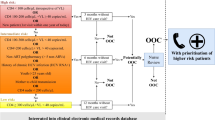Abstract
To examine whether integration of Health Information Exchange (HIE) services into office workflow would have an impact on ED visits and unplanned 30-day readmission amongst the patients who were treated at the medical practice. We designed and implemented a training program at a medical practice in Western New York over a period of three months between November 2016 and January 2017. During the program, a group of health IT professionals and clinical specialists trained the staff on how to appropriately use and efficiently integrate the HIE services in their workflow. We measured the effectiveness of the program using both qualitative and quantitative methods. We employed an Interrupted Time Series (ITS) analysis to examine the effectiveness of the program on reducing the number of patients who experience an ED visit or an unplanned hospital readmission within 30 days of initial discharge. After the implementation of the training program, the rate of unplanned hospital readmissions reduced by 2.7 patients per 1000 members per month and the rate of ED visits reduced by 6.3 patients per 1000 members per month. The results indicate that educating medical practices on how to efficiently utilize the HIE services, and especially the notification systems will significantly reduce the rate of ED utilization and unplanned 30-day hospital readmissions amongst the patients of medical practices.


Similar content being viewed by others
References
Buntin, M. B., Burke, M. F., Hoaglin, M. C., & Blumenthal, D. (2011). The benefits of health information technology: A review of the recent literature shows predominantly positive results. Health Aff (Millwood), 30(3), 464–471.
Ceccagnoli, M., Forman, C., Huang, P., & Wu, D. J. (2012). Cocreation of value in a platform ecosystem! The case of enterprise software. MIS Quarterly, 263–290.
Davis K. (2014). Mirror, mirror on the wall: How the performance of the US health care system compares internationally: 2014 update. Commonwealth Fund.
Eftekhari, S., Yaraghi, N., Singh, R., Gopal, R. D., & Ramesh, R. (2017). Do health information exchanges deter repetition of medical services? ACM Trans Manag Inf Syst TMIS, 8(1), 2.
Hyndman, R. J. (1993). Yule-Walker estimates for continuous-time autoregressive models. Journal of Time Series Analysis, 14(3), 281–296. https://doi.org/10.1111/j.1467-9892.1993.tb00145.x.
Lee, H. G., Clark, T., & Tam, K. Y. (1999). Can EDI benefit adopters? Information Systems Research, 10(2), 186–195.
Lu, C. Y., Zhang, F., Lakoma, M. D., et al. (2014). Changes in antidepressant use by young people and suicidal behavior after FDA warnings and media coverage: quasi-experimental study. BMJ, 348, g3596. https://doi.org/10.1136/bmj.g3596.
Menachemi, N., Rahurkar, S., Harle, C. A., & Vest, J. R. (2018). The benefits of health information exchange: An updated systematic review. Journal of the American Medical Informatics Association, 25(9), 1259–1265. https://doi.org/10.1093/jamia/ocy035.
Rudin, R. S., Motala, A., Goldzweig, C. L., & Shekelle, P. G. (2014). Usage and effect of health information exchange: A systematic review. Annals of Internal Medicine, 161(11), 803–811.
Soumerai, S. B., Ross-Degnan, D., & Kahn, J. S. (1992). Effects of professional and media warnings about the association between aspirin use in children and Reye’s syndrome. The Milbank Quarterly, 70(1), 155–182. https://doi.org/10.2307/3350088.
Unruh, M. A., Jung, H.-Y., Kaushal, R., & Vest, J. R. (2017). Hospitalization event notifications and reductions in readmissions of Medicare fee-for-service beneficiaries in the Bronx, New York. Journal of the American Medical Informatics Association, 24(e1), e150–e156.
Walker, J., Pan, E., Johnston, D., Adler-Milstein, J., Bates, D. W., & Middleton, B. (2005). The value of health care information exchange and interoperability: There is a business case to be made for spending money on a fully standardized nationwide system. Health Aff (Millwood), 24(Suppl1), W5–W10.
Yaraghi N. (2015) The benefits of health information exchange platforms: Measuring the returns on a half a billion dollar investment. Center for Technology Innovation at Brookings.
Yaraghi, N., & Gopal, R. D. (2018). The role of HIPAA omnibus rules in reducing the frequency of medical data breaches: Insights from an empirical study. The Milbank Quarterly, 96(1), 144–166.
Yaraghi, N., Du, A. Y., Sharman, R., et al. (2013a). Professional and geographical network effects on healthcare information exchange growth: Does proximity really matter? Journal of the American Medical Informatics Association, 21(4), 671–678.
Yaraghi, N., Du, A. Y., Sharman, R., Gopal, R. D., & Ramesh, R. (2013b). Network effects in health information exchange growth. ACM Trans Manag Inf Syst TMIS., 4(1), 1.
Yaraghi, N., Du, A. Y., Sharman, R., Gopal, R. D., & Ramesh, R. (2014). Health information exchange as a multisided platform: Adoption, usage, and practice involvement in service co-production. Information Systems Research, 26(1), 1–18.
Yaraghi, N., Sharman, R., Gopal, R., Singh, R., & Ramesh, R. (2015). Drivers of information disclosure on health information exchange platforms: Insights from an exploratory empirical study. Journal of the American Medical Informatics Association, 22(6), 1183–1186.
Yaraghi, N., Gopal, R. D., & Ramesh, R. (2019). Doctors’ orders or patients’ preferences? Examining the role of physicians in patients’ privacy decisions on health information exchange platforms. Journal of the Association for Information Systems, 20(7), 14.
Author information
Authors and Affiliations
Corresponding author
Additional information
Publisher’s Note
Springer Nature remains neutral with regard to jurisdictional claims in published maps and institutional affiliations.
Electronic Supplementary Materials
ESM 1
(PDF 286 kb)
Rights and permissions
About this article
Cite this article
Fecher, K., McCarthy, L., Porreca, D.E. et al. Assessing the Benefits of Integrating Health Information Exchange Services into the Medical Practices’ Workflow. Inf Syst Front 23, 599–605 (2021). https://doi.org/10.1007/s10796-019-09979-x
Published:
Issue Date:
DOI: https://doi.org/10.1007/s10796-019-09979-x




